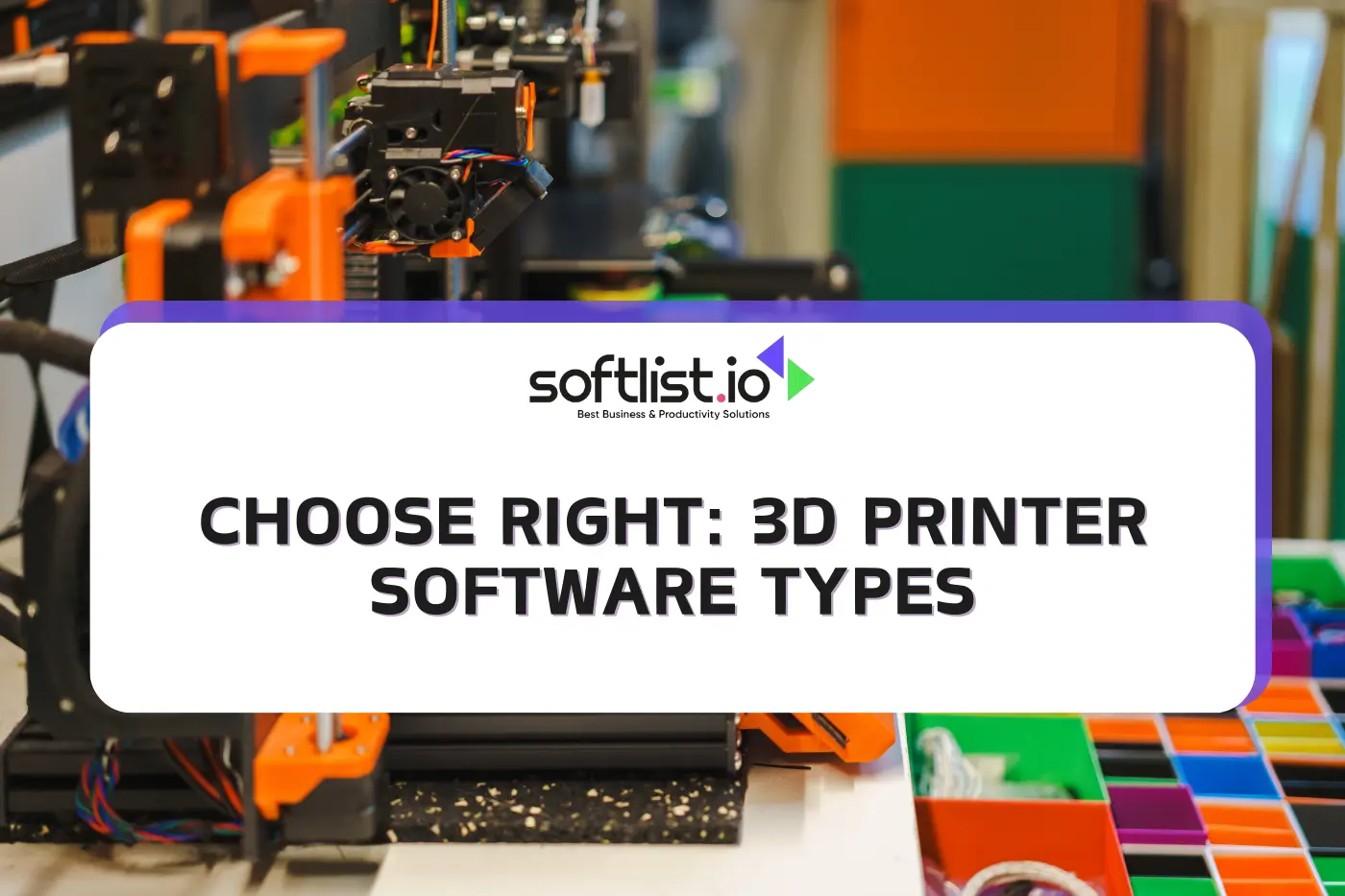Are you ready to learn about 3D printing? Whether you’re a hobbyist or a professional, the right software can make all the difference in bringing your designs to life. In this guide, we’ll explore the top picks for 3D model printing software, highlighting options that are easy to use and powerful enough for designing complex 3D models.
From widely used 3D printing software to advanced tools for 3D printer management, we’ve got you covered. Our list focuses on what software is used for 3D printing, highlighting vital tools such as CAD for design, slicer software for model translation, and print management tools.
We’ll also discuss the accessibility to ensure you locate solutions that work within your budget. Prepare to learn how these software options can help you boost your 3D printing projects and turn your creative ideas into reality.
Exploring 3D Printing Software

3D printing software refers to a category of programs designed to facilitate the 3D printing process, which converts digital models into physical three-dimensional objects through additive manufacturing. 3D printing software empowers anyone to create amazing things, from beginners to experts. It’s like having a workshop on your computer, letting you design anything you imagine!
Here’s what you need to know about the 3D printing software features:
Design Software
Software plays a crucial role in 3D printing by allowing users to create and manipulate digital designs that can be printed. Powerful CAD (computer-aided design) software like Autodesk Fusion 360 and SolidWorks, a professional 3D modeling software enable users to create intricate and precise 3D models that can be customized for different 3D printing processes and materials.
Slicing Software
Slicing software is essential for 3D printing as it translates the digital 3D model into a set of instructions for the 3D printer. This software directs the printer on how to deposit material layer by layer, and it also controls parameters such as layer thickness, infill density, and print speed.
Printer Control Software
Hardware and software are closely intertwined in 3D printing, as the 3D printing software communicates directly with the 3D printer’s hardware to execute the complex 3D printing process. This software, the tool for 3D printer hosts, ensures that the printer operates smoothly, accurately, and efficiently.
Material Considerations for 3D Modeling Software like 3D Slash
Software also plays a role in material considerations for 3D printing. Advanced software can simulate the behavior of different materials during the printing process, allowing users to optimize settings for specific materials and achieve the desired mechanical properties in the final printed part.
Intersection with Hardware
The intersection of software and hardware is critical in 3D printing, as the software must be compatible with the specific hardware components of the printer. Software that enables the control and monitoring of 3D printers considers factors such as temperature control, extrusion mechanisms, and build platforms.
Key Types of 3D Printing Software
When it comes to 3D printing, choosing the right software is crucial for success. Here are the key types of 3D printing software you should know about:
1. 3D Modeling Software
3D modeling software is where the design process begins. This type of software allows users to create and manipulate 3D models. It’s designed for both beginners and experts, offering a range of tools from basic shapes to complex geometric constructions. Popular choices include:
- TinkerCAD: Easy to use, ideal for beginners.
- Blender: Widely used for designing complex 3D models with a steep learning curve.
- SolidWorks: Advanced software with robust features for professional engineers.
2. Slicing Software
Slicing software converts 3D models into instructions that a 3D printer can understand. This process involves slicing the model into layers and generating G-code, which controls the printer’s movements. Key features often include customizable settings for layer height, infill, and print speed. Leading slicing software includes:
- Cura: Free and widely used 3D printing software known for its user-friendly interface.
- Simplify3D: Premium software with advanced settings and optimization tools.
- PrusaSlicer: Designed specifically for Prusa printers but versatile enough for other brands.
3. Printer Management Software
Printer management software helps oversee and control the 3D printing process. This type of software can monitor print jobs, manage multiple printers, and even allow remote access. It’s essential for those who need to streamline their printing workflow. Notable examples are:
- OctoPrint: Open-source and highly customizable, perfect for remote 3D printer management.
- AstroPrint: Cloud-based solution that simplifies printer management and monitoring.
- Repetier-Server: Offers extensive control over multiple printers and detailed print job analytics.
4. Simulation Software
Simulation software is used to predict and visualize how a 3D print will perform under various conditions. It helps in identifying potential issues before the actual printing begins, saving time and resources. Popular options include:
- Autodesk Netfabb: Provides advanced simulation and optimization tools.
- ANSYS Additive Suite: Designed for industrial applications, offering comprehensive simulation capabilities.
5. Repair Software
Repair software is essential for fixing issues in 3D models that could lead to print failures. It identifies and corrects errors such as holes, non-manifold edges, and intersecting faces. Reliable repair software includes:
- Meshmixer: Easy to use and widely adopted for model repair and modification.
- Netfabb Basic: Offers robust repair tools in its free version.
- Magics: An industrial-grade solution for comprehensive model repair and optimization.
By understanding the key types of 3D printing software, you can choose the right tools to ensure a smooth and successful 3D printing experience. Whether you’re designing complex 3D models, managing multiple printers, or optimizing your prints, there’s a software solution designed to meet your specific needs.
CAD Software: Designing Your 3D Models

3D CAD software is crucial in designing 3D models for product design in various industries such as architecture, engineering, and manufacturing. It allows users to create detailed and realistic models that can be used for visualization, analysis, and production.
Key features of CAD software for 3D modeling include:
1. Parametric design: Allows users to create models with adjustable parameters, making it easy to make changes and modifications to the design.
2. Assembly modeling: 3D CAD, a 3D printing tool, enables users to create complex assemblies for product design by combining multiple parts and components using parametric modeling.
3. Simulation and analysis: CAD software often includes CAD tools for simulating and analyzing the performance of 3D models, such as stress analysis and fluid dynamics.
4. Rendering and visualization: This is a key aspect of 3D animation software. Users can generate realistic images of their 3D models using advanced software tools for presentations and marketing purposes.
Choosing the Right Software for Your Needs
1. User Skill Level
- For beginners: Choose 3D Slash, a user-friendly and intuitive 3D modeling tool with essential features and easy navigation for beginners and advanced users.
- For intermediate users: Look for software with more advanced features and customization options.
- For advanced users: Consider software with complex tools and extensive capabilities for advanced printing needs.
2. Printing Needs
- For basic printing: Consider software with essential print settings and templates for simple printing tasks.
- For specific printing requirements (e.g. photo editing, graphic design): Look for software tailored to those needs, such as photo editing software or graphic design tools.
- For professional printing: Choose 3D modeling software with high-quality output, color management, and advanced printing options.
Cost and Accessibility of 3D Printing Software
The software market has evolved significantly over the years, adapting to technological changes, user needs, and business models. We will look into the current landscape of the software market, focusing on pricing models, subscription services, and free options, which are crucial factors influencing consumer choice and company strategies.
Pricing Models
The pricing models for software products and services vary widely and are designed to cater to different market segments, usage patterns, and customer preferences.
Below are the most common pricing models in use today:
- 3D CAD Software: One-Time Purchase: Traditionally, software was sold as a one-time purchase, granting the buyer a perpetual license to use the software. This model is still prevalent for certain types of software, especially those used in professional environments where long-term stability is valued over constant updates.
- Subscription-Based 3D Modeling Software: Subscription models have gained popularity, especially with cloud-based services, offering ongoing access to software for a recurring fee. This advanced 3D model ensures users always have access to the latest features and updates and allows companies to generate steady revenue streams.
- 3D CAD Freemium Software: The freemium model offers a basic version of the software for free, with the option to pay for premium features so the user can control the entire 3D printing process. This approach is practical for gaining a large user base quickly, as it lowers the barrier to entry for new users looking for 3D printing software programs.
- Free Trial: Many companies offer their software a free trial period, allowing users to test the software’s full features before committing to a purchase. This model often attracts users to subscription services or one-time purchase software.
- Tiered Pricing for Advanced 3D Printing Tools Software programs needed for creating 3D printable objects may be offered in multiple top tiers, each with a different price and set of features, suitable for beginners and advanced users. This model caters to a broad range of users, from individuals or small businesses to large enterprises, by offering flexible pricing based on the features and support required in the entire 3D printing process.
Subscription Services
Subscription services are now dominant in the software market, reflecting a shift towards SaaS (Software as a Service) and cloud computing.
Key aspects include:
- Predictable Expenses with 3D Slash: Subscriptions to software applications that enable 3D printing provide predictable monthly or annual expenses, which can be more manageable for businesses and individuals.
- Scalability: Users can often adjust their subscription level as their needs change, making it easier to scale up or down without significant upfront costs.
- Automatic Updates: Subscriptions usually include automatic updates, ensuring users always have access to the latest features and security patches.
Free Options
Free software options, including open-source and freemium models, have a significant presence in the market, characterized by:
- Open-Source Software: Open-source software is free and can be modified and shared. This model encourages community collaboration and has led to the development of robust software ecosystems.
- Freemium Models: As mentioned, freemium models of 3D modeling software offer basic functionality for free, with advanced features available for a professional 3D designing fee. This approach allows users to try 3D printing software applications with no financial commitment.
The software market, the market of 3D mechanical design software, continues to evolve, with diverse pricing models and offerings that cater to a wide range of needs and preferences when creating 3D models.
The choice between subscription services, one-time purchases, and free software depends on various factors, including the user’s specific needs, budget considerations, and the value of ongoing updates and support.
As the market evolves, flexibility and adaptability in pricing models of 3D modeling software will remain vital in meeting the changing demands of consumers and businesses alike.
Conclusion
Selecting the right 3D printing software is paramount to achieving high-quality prints and a seamless workflow. The software used in the process can range from powerful 3D modelers like Blender and SolidWorks to intuitive slicers such as Cura and Simplify3D.
These tools ensure that your designs are accurately translated into printable instructions. Additionally, 3D printer software like OctoPrint and AstroPrint makes overseeing your printing operations quite accessible, allowing for efficient and remote control. No matter your skill level or project complexity, there’s a software solution designed to meet your needs and ensure your 3D printing endeavors are successful.
By understanding how each software works and leveraging their strengths, you can optimize your designs and streamline your printing process. As 3D printing software advances, the software that supports it becomes increasingly important in fostering innovation, customization, and efficiency in the additive manufacturing ecosystem.
FAQs – What Software is Used for 3D Printing
What Are the Best 3D Printing Software Options Available?
Some of the best 3D printing software tools include Blender, SketchUp, Tinkercad, OpenSCAD, and Slic3r.
Which Software Is Widely Used for 3D Printing?
SketchUp is a 3d modeling program that is widely used among beginners and professionals alike for its ease of use and versatile tools.
What Are Some Key Features to Consider When Choosing the Best 3D Printing Software?
When selecting 3D printing software, consider factors like user interface, ease of use, mesh modeling capabilities, support for various file formats such as STL and G-code, and advanced design features.
Can Beginners Use Software like Blender for 3D Printing?
While Blender is a powerful 3D printing software tool with advanced capabilities, it may have a steeper learning curve for beginners. There are other programs like Tinkercad that are more user-friendly for novice users.
What Is the Importance of STL File Format in 3D Printing Software?
The STL file format is crucial in 3D printing software as it defines the surface geometry of a 3D model using a collection of triangles, making it compatible with most 3D printers and slicing software.
How Does Parametric 3D Modeling Software Differ from Mesh Modeling Software?
Parametric 3D modeling software like OpenSCAD allows users to create designs based on specific parameters and dimensions, whereas mesh modeling software focuses on manipulating vertices, edges, and faces to create 3D models.
Is There Any Open-Source 3D Printing Software Available for Users?
Yes, there are open-source 3D printing software tools like Blender, OpenSCAD, and Slic3r that offer users free access to advanced 3D modeling and printing capabilities.
Discover More with Softlist.io, a Platform Offering Free 3D Modeling Software
Embark on a journey to unlock the full potential of your projects with Softlist, your ultimate destination for comprehensive, unbiased software advice.
Whether you’re delving into the intricate world of 3D printing, seeking innovative project management tools, or exploring creative graphic design software, Softlist.io is here to guide you through a curated selection of top-tier software solutions.
Moreover, be sure to check out our latest deals and special offers to find discounts on the software you need.







